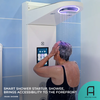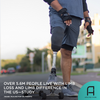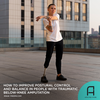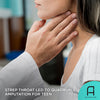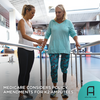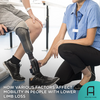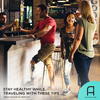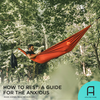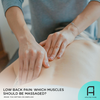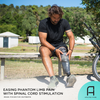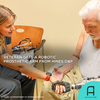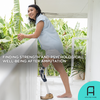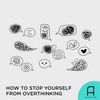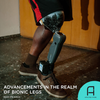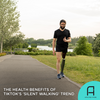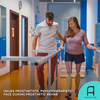A Bathtub Safety Guide for Amputees
The bathroom is one of the most visited rooms in the home. We use that tiny room to prepare and make ourselves look presentable to the rest of the world. And, of course, in that little room, we take the time to shower or bathe regularly. However, in spite of the number of daily visits to the bathroom, we rarely question how safe we are in that space.

The Real Score
Statistics show that accidents at home most commonly occur in the bathroom. The Centers for Disease Control and Prevention (CDC) reported that approximately 235,000 people over the age of 15 are sent to the emergency room annually due to injuries in the bathroom—with two-thirds of those injuries acquired during bathing or showering (CDC, 2011).
The numbers are not surprising; several factors contribute to bathroom-related accidents like slippery floors due to water, shampoo, conditioner, and liquid soap, among others. Wet floors are also among the top reasons why most amputees prefer to take baths than showers, as well as sit when showering.
Advantages of Bathing
The benefits of bathing are numerous. Soaking one’s self in a tub filled with warm water helps ease or minimize all sorts of discomfort, from phantom pain to limb numbness due to cold temperatures. Also, bathing compared to showering can be a “one-stop-shop” for amputees to clean themselves easily. After all, it’s easier to clean yourself when you’re seated comfortably and safely in a tub than when you're trying to stand or lean against a stable surface.
While it may seem that bathing outweighs showering, we still can’t ignore the safety issues you face whenever you decide to bathe in a tub. In this article, we break down how to safely get in and out of the tub so that you can enjoy your bath time.
Tips for Entering the Bathtub
One of the most popular tools that you should consider in your bath area is a grab bar. It's the best tool to hold on to when you're getting inside the bathtub. When entering it's best to settle into the tub with your sound side and ensure you have your balance before raising your residual limb off the tub floor.
When you're ready to leave the tub, simply hold on to the grab bar for support until you can swing your residual limb over and safely place your foot on the floor. Once you're able to do this, you can let go of the grab bar and grip on to the edge of the tub. This transition will then make it easier for you to stand firmly on the ground.
While some find that installing a grab bar a great solution to ensure bathtub safety, others may need a different strategy. And the strategy depends on how their body feels on any given day.
Other acceptable ways of entering the bathtub include entering with and without your prosthesis as well as removing the prosthesis on the edge of the tub or while sitting on a chair or the toilet. Entering with your prosthesis attached is deemed to be the safest option as it provides more stability and balance.
Below, we break down the different ways you can enter and exit the bathtub according to amputation level:
For below-the-knee (BK) amputees:
• Unilateral approach
Sit on the edge of the tub and remove your prosthesis and liner. Reach for the grab bar or the tub edge. Always make sure that the grab bar is dry before putting your full weight on it.
Then, bring your residual limb over the edge and kneel. Shift your weight onto your residual limb if necessary, while holding on to the grab bar. Transfer your sound side into the tub. Put your foot down and ensure that you have regained your balance before kneeling down on that same knee.
After achieving a tall kneeling stance, you can now sit down with your sound side foot leading in front or by shifting your weight towards your sound side and lowering yourself slowly while holding onto the grab bar and the side of the tub.
If you are a new amputee, know that practice makes perfect. Understanding how your body feels will help you figure out how to enter the bathtub.
• Bilateral amputee approach
This approach is a lot similar to the unilateral approach. However, the difference is that you’ll need to use your upper body strength to swing both your legs over the edge of the tub. Then, to lower yourself from a kneeling position once you’re in the tub, the same upper body strength is required.
When removing your prosthesis, your safest option is to sit on the edge of the tub with your legs inside the tub. After you take your prosthesis off, transfer into the tub and turn the water on.
For above-the-knee (AK) amputees:
• Unilateral approach
Follow the same steps for BK amputees, except you need to put more weight and pressure on your sound side. You can use your residual limb for balance as long as you're comfortable.
Once you achieve the tall-kneeling position, place your residual limb in front of you while gripping the grab bar for additional balance and support. Then, slowly sit down.
• Bilateral approach
Bilateral AK amputees will experience more difficulty with entering and exiting a bathtub, but it can be done safely with practice and physical therapy. It is highly recommended to seek your occupational therapist’s (OT) advice on safe methods as well as equipment to help you enter and exit the bathtub safely.
You can also use a wedge cushion to keep yourself from sliding forward while inside the tub. The cushion should be facing backward, with the highest part away from you. We recommend using a waterproof version because wedge cushions do not dry quickly. Another alternative is using extra adhesive stickers.
Tips for Exiting the Bathtub
There are several strategies you can use to leave the bathtub safely. One is to dry off the tub edge that is against the wall. Then, swing your legs over the side, and use both arms on each tub edge to push yourself upwards and out of the tub.
For those whose upper body strength needs a bit of work, kneeling can serve as a transition phase before moving out of the tub. Hold on to the grab bar for additional support.
Another strategy you can consider is placing stickers to mark the best spots that you can hold onto in the tub.
Don't feel discouraged if your current strategy is no longer working for you. It's alright to switch strategies, depending on how your body feels. There are a lot of factors that can affect these changes, such as weight gain or loss, so don't feel like you have to stick to one strategy. What's important is knowing which one works best for you in any given situation.
Bathtub Safety Tools
Grab bars are the most recommended bathtub safety tool as they offer additional support while you're inside the tub. There are different types of grab bars that you can use: the bathtub bar, the bath and shower handle, and the flip-up grab bar. These can be purchased on Amazon, Lowe's, Home Depot, or in other supply stores. If you're not sure which one to use, consult your OT or support group.
If you decide to get grab bars for your bathroom, we advise drilling them into the wall instead of using adhesive suction cups which are less sturdy.
The second bathtub safety tool that you should consider are bath kneelers which can be used for additional support as you prepare to step inside the bathtub. These pads can provide extra comfort for bilateral or unilateral below-knee amputees when preparing to enter the tub.
Lastly, if you're not comfortable sitting on the tub edge to apply or remove your prosthesis, you might want to get yourself a bath safety step. This tool can also help bilateral below-knee amputees who find it difficult to kneel down entirely on to a bath mat.
Comfort and Safety in the Tub
Once you're in the tub, more safety issues can arise. You can make your bath time safer and more comfortable with bath mats, which come in various textures and shapes. Make sure you choose one that is easy to clean.
We recommend applying adhesive stickers to your bathtub. When installing these stickers, make sure to stick them on to the tub's dry surface and wait for the maximum time indicated by the manufacturer before allowing water into the tub for the first time. This ensures that the stickers don't immediately slip or move around.
Hygiene Tips
While baths are known for being relaxing, they're not exactly hygienic. It can be quite challenging to wash your hair in the sudsy tub water properly. However, certain tools can help you get the job done.
One is a spout cover which allows you to place your hair directly underneath the faucet with controlled water flow. You can also use the spout cover to wash your hair in the sink.
Another option is a shampoo rinse cup which allows you to pour water over your head and wash your hair effectively. Rinse cups enable you to control the amount of water poured over your body as well. Use this in conjunction with a handheld shower head for maximum control and direction.
The Bottom Line
Navigating the bathtub can be understandably complicated for leg amputees. But the benefits of bathing still outweigh the risks of standing in the shower. Create a safer and more enjoyable bath experience by following the safety precautions discussed in this article. Also, it's better to install more than one bathtub safety tool because each day can present different challenges that require different tools.
How do you make your bath time safe and comfortable? Share with us your tips in the comments section below.



























